-
1 阅读
-
2 阅读
-
3 阅读
-
4 阅读
-
5 阅读
-
6 阅读
-
7 阅读
-
8 阅读
-
9 阅读
 Scales
Scales
音阶
Pitch Structure: Scales
音高结构:音阶
A musical scale is a collection of notesordered by ascending or descending pitch (also called a stepwise ordering).Listen to the following example from the opening of Monteverdi's Orfeo.
音阶是按升序或降序排列的音符集合(也称为逐步排序)。从Monteverdi的Orfeo开始听下面的例子。
Example 15. Opening Toccata fromMonteverdi's Orfeo.
例15.从Monteverdi的Orfeo打开Toccata。
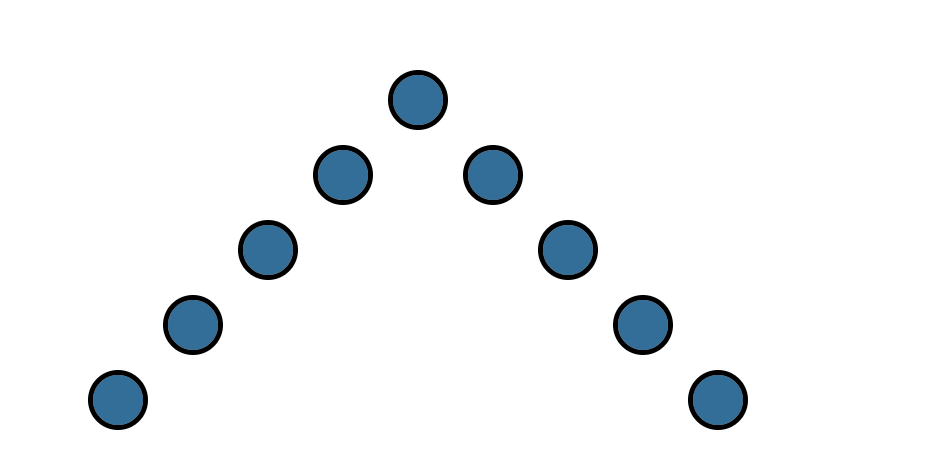
The opening flourish uses a five-note scalethat ascends quickly and then descends through those same pitches more slowly.Listen to the notes of the same scale played more evenly on a piano.
开放的音阶发展使用一个快速上升的五音符音阶,然后通过相同的音高慢慢下降。听相同音阶的音符在钢琴上演奏得更均匀。
Music uses a variety of scales, which aredistinguished by the specific intervals (called steps) between notes. Two verycommon musical scales are called the major and minor scales, our next topics.
音乐使用各种音阶,这些音阶通过音符之间的特定时间音程(称为音级)来区分。两个非常普遍的音阶被称为主要和小音阶,这是我们的下一个主题。
 The Major Scale
The Major Scale
大调音阶
Pitch Structure: The Major Scale
音高结构:大调音阶
The major scale is a collection of notes spanning an octave that follows thestepwise ascending interval pattern: Tone, Tone,semitone, Tone, Tone, Tone, semitone (T-T-s-T-T-T-s). Because the steps of thescale are tones and semitones, the intervals between adjacent notes of thescale are called whole steps and half steps respectively. Example 16illustrates a major scale graphically.
大调音阶是一个跨越八度的音符集合,它遵循逐步上升的音程模式:全音,全音,半音,全音,全音,全音,半音(T-T-s-T-T-T-s)。因为音阶是全音和半音,所以音阶的相邻音符之间的音程分别被称为整个音阶和半个音阶。示例16以图形方式说明主要音阶。
Example 16. The major scale.
例16. 主要音阶
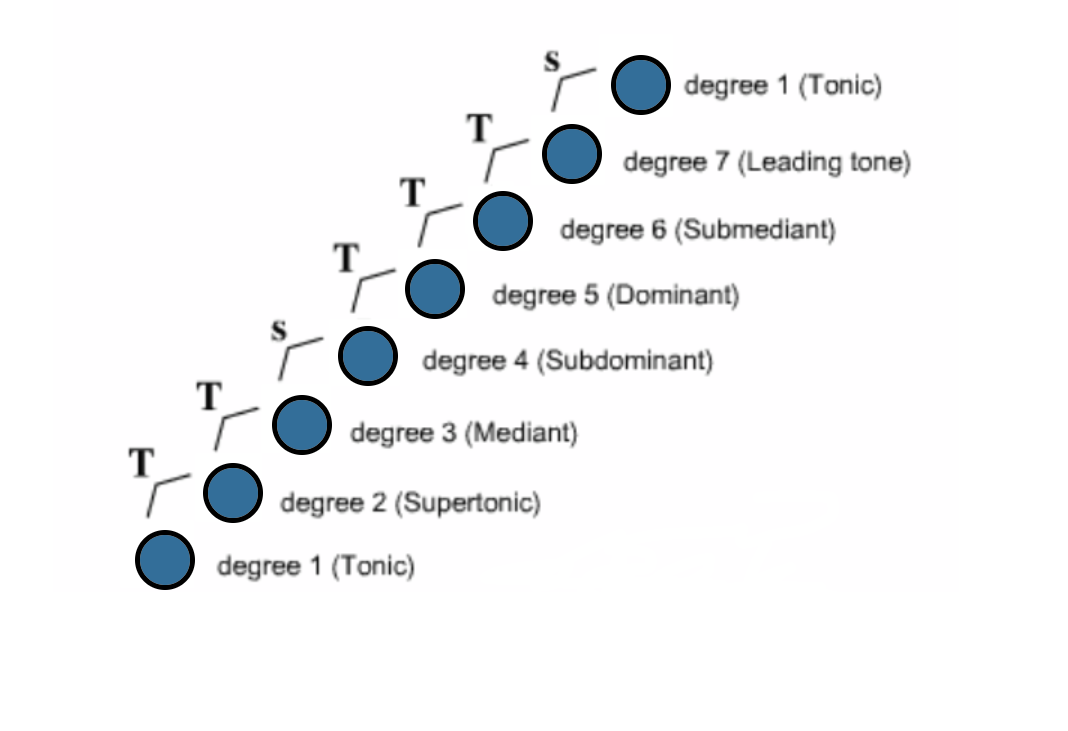
Thenotes that make up the major scale are called scaledegrees, and are numbered 1 through 7 ascending. The highest note, an octaveabove scale degree 1 is also scale degree 1 (again, because of octaveequivalence). Notes of the scale can continue above and below those shown here,repeating the pattern T-T-s-T-T-T-s in different octaves (i.e. there is a scaledegree 2 a whole tone above the highest note on the figure, a scale degree 3 awhole tone above that, a scale degree 7 a semitone below the lowest note on thefigure, and so on). The scale degrees are also referred to by other names.Scale degree 1 is also called the tonic. Scale degree 2 is also called thesupertonic (meaning "above the tonic"). Scale degree 5 is called thedominant. Scale degree 4 is called the subdominant (because it is as far belowthe tonic--four steps down--as the dominant is above). Scale degree 3 is calledthe mediant (because it "mediates" or lies in the middle between thetonic and the dominant). Degree 6 is the submediant (mediating between tonicand subdominant), and so on.
构成大调音阶的音符称为音阶,并被编号为1至7。最高的音符,音阶1度以上的八度音阶也是音阶1度(同样是八度)。音阶的音符可以继续在这里所示的上和下,在不同的八度中重复TTsTTTs模式(即在音高最高的音符之上有一个整音调的音阶2度,音阶3度以上的音调,比图中最低音符低7个半音,等等)。音阶度也被称为其他名称。音阶1度也称为主音。音阶2度也被称为超音速(意思是“超主音”)。 5级称为主音。 4级称为次主音(因为它远远低于主音 - 四级降低 - 因为在上面占优势)。 3级称为中音(因为它“介入”或位于主音和占主导地位的中间)。 6级是下中音(介于主调音和次属音之间),等等。
Once again using the piano keyboard,Example 17 illustrates how the step pattern of the major scale coincidesexactly with the notes of the white keys from C to C: C to D is a whole tone orwhole step, D to E is a whole step, E to F is a semitone or half step, F to Gis a whole step, G to A is a whole step, A to B is a whole step, and B to C isa half step. The collection of notes C-D-E-F-G-A-B-C is thus called a C-majorscale, because it starts on C and follows the interval pattern of the majorscale.
例17再次使用钢琴键盘说明了主音阶的阶梯模式如何与从C到C与白键的音符完全重合:C到D是整个音调或整个步骤,D到E是整个步骤,E到F是半音或半音阶,F到G是整个音阶,G到A是整个音阶,A到B是整个音阶,B到C是半音阶。 C-D-E-F-G-A-B-C音符的集合因此被称为C大调音阶,因为它从C开始并遵循主音阶的音程模式。
Example 17.
例17。

Major scales can occur, however, on anystarting pitch. For example, if we start on the pitch D, we ascend by wholetone to E, by whole tone from E to F#, by semitone from F# to G, by whole tonefrom G to A, by whole tone from A to B, by whole tone from B to C#, and bysemitone from C# to D. The collection D-E-F#-G-A-B-C#-D forms the D-majorscale. Note that each scale degree of the D-major scale is exactly one wholetone higher than the corresponding scale degree of the C-major scale. Such ashifting (up or down) of notes (be they a notes of a scale or an entire passageof music) is called a transposition.
但是,任何起始点都可能出现大的音阶。例如,如果我们从音调D开始,我们用整个音调上升到E,从E到F#的整个音调,从F#到G的半音,从G到A的整个音调,从A到B的整个音调,从B到C#的整个音调,以及从C#到半音的半音。集合DEF#-GABC#-D形成D大调。请注意,d -大音阶的每一个音阶都比c大音阶的相应音阶度高一个整音。音符的这种移位(向上或向下)(称为音阶或整个音乐段落)被称为转位。
Many musical works that use the notes of amajor scale do not necessarily use those notes in stepwise order. Scales may beviewed as abstract ordered collections of pitches; actual pieces may or may notexhibit that abstract ordering. In this sense, scales are more like palettes ofpitches from which composers can create musical works. Example 18 illustrateshow Handel uses notes from an E-major scale (E-F#-G#-A-B-C#-D#-E) in the aria"Ev'ry valley shall be exalted."
许多使用大音阶音符的音乐作品不一定按照顺序使用这些音符。可以将音阶视为抽象的有序的音高集合;实际的作品可能会或可能不会表现出抽象的顺序。从这个意义上说,音阶更像是作曲家创作音乐作品的音调调色板。例18说明了Handel如何使用电子大调(E-F#-G#-A-B-C#-D#-E)中的音符“埃夫里山谷将被崇高”。
Example 18. Handel, "Ev'ry valleyshall be exalted."
例18 亨德尔:“埃夫里山谷将被崇高。”
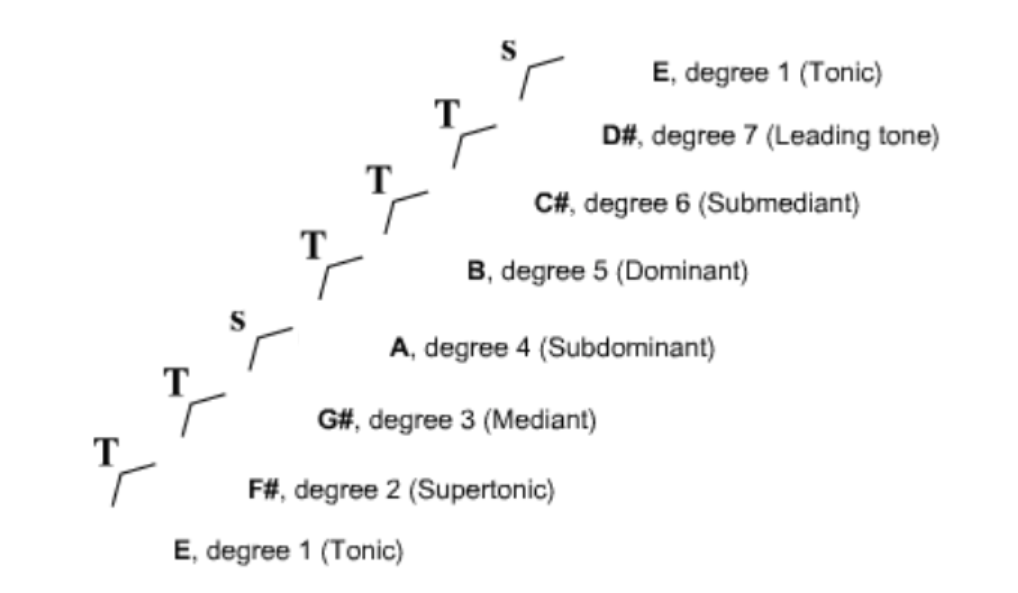
Notice how the singer skips around thenotes of the scale going up, before coming down the scale by step.
请注意歌手如何跳过音阶的音符,然后逐步缩小音阶。
NOTE: Are you curious why we write thenotes of the D-major scale, for example, with F# and C# rather than with Gb andDb? Obviously, the scale would sound the same regardless of the spelling.However, it is conventional to write the notes of a major scale such that theycycle through some form of all seven letters of the note names, A through G,consecutively. For example, if in D-major we wrote D-E-Gb-G... and so on, wewould have skipped from E to a note whose name is a modified form of G (i.e.there would no form of F represented). We would also end up with two notesnamed G, albeit one a modified form of the other. By using F# and C# in theD-major scale, every of the seven letters is represented.
注意:你是否好奇我们为什么用F#和C#而不是Gb和Db来编写D大调的音符?显然,不管拼写是什么,音阶都是一样的。然而,传统的做法是写出一个主要音阶的音符,使得它们可以连续循环音符名称A到G的所有七个字母的某种形式。例如,如果在D大调中,我们写了D-E-Gb-G ...等等,我们将从E跳到一个名字是G的修饰形式的音符(也就是说没有表示F的形式)。我们最后还会得到两个叫做G的音符,尽管一个是另一个音符的修改形式。通过使用D大小的F#和C#,七个字母中的每一个都被表示出来。
 The Minor Scale
The Minor Scale
小调音阶
Pitch Structure: The Minor Scale
音高结构:小调音阶
The minor scale (also called the naturalminor scale) is a collection of notes spanning an octave that follows thestepwise ascending interval pattern: Tone, semitone, Tone, Tone, semitone,Tone, Tone (T-s-T-T-s-T-T). The minor scale is illustrated graphically inExample 19.
小调音阶(也称为自然小调音阶)是一个跨越八度的音符集合,它遵循逐步上升的音程模式:音调,半音,音调,音调,半音,音调,音调(T-s-T-T-s-T-T)。小调音阶在例19中以图形方式说明。
Example 19. The (natural) minor scale.
例19.(自然)小调。

The minor scale, just like the major scale,labels its notes using scale degrees. The other names are similar, too, (tonic,supertonic, etc.) with the exception of scale degree 7, which is given the namesubtonic. (The name leading tone is reserved for degree 7 only when it is asemitone below the tonic.) The big difference between major and minor scales issimply the pattern of intervals each exhibits relative to their tonics.
小调音阶就像主要音阶一样,用音阶度来标注它的音符。其他的名字和除了音阶7以外的音符相似(强音,超强音等),其名称是低强音。(只有在主音低于半音的情况下,名字才被保留为音阶7)。主要和小音阶之间的巨大差别仅仅是每个音素相对于其音节的音程的模式。
Example 20 illustrates how the naturalminor pattern of whole steps and half steps occurs among the white keys of apiano keyboard from A to A, thus forming the A-minor scale.
例20说明了从A到A的钢琴键盘的白键之间如何发生整个音步和半音步的自然小调模式,从而形成A-小调音阶。
Example 20.
例20
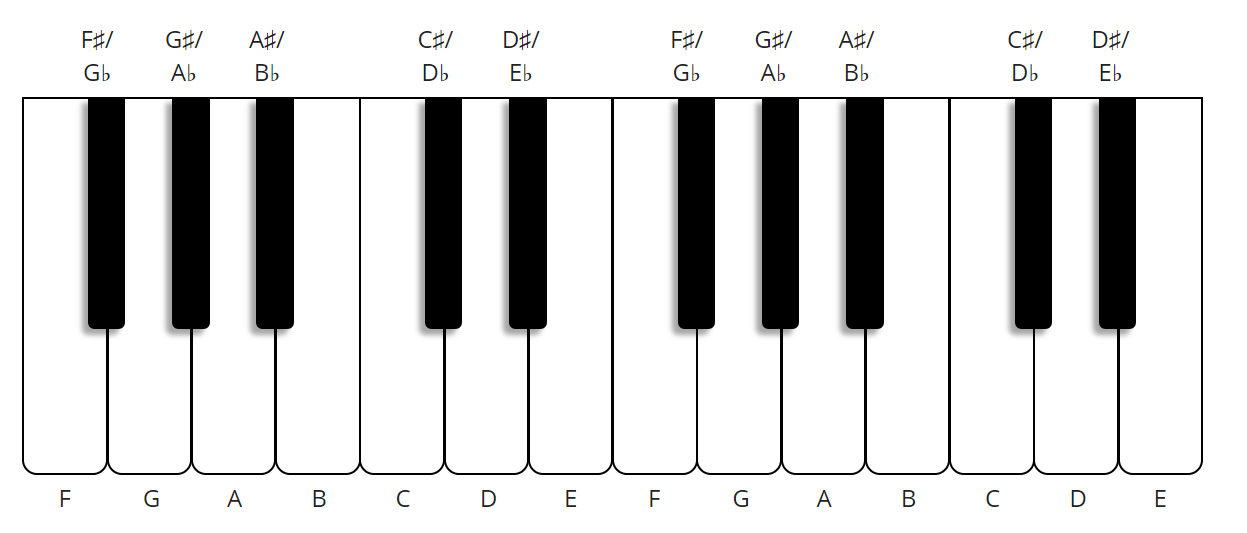
A小调
C小调
Of course, the minor scale can be built onany starting note. For example, if C is the tonic, then the c-minor scalecomprises the notes C-D-Eb-F-G-Ab-Bb-C. Example 20 also plays the c-minorscale. One can compare the sound of the c-minor scale to that of the C-majorscale.
当然,小调音阶可以建立在任何开始音符上。例如,如果C是主音,则C小调音阶包括音符C-D-Eb-F-G-Ab-Bb-C。例20也播放c-小调音阶。我们可以比较C小调音阶和C大调音阶的声音。
In musical practice, variations of thenatural minor scale minor scale are often used. Such forms involve modificationsof scale degrees 6 and 7. The harmonic minor scale raises the seventh degree ofthe scale by a semitone (i.e. it turns scale degree 7 into a leading tone);A-harmonic-minor comprises the notes A-B-C-D-E-F-G#-A. The A-melodic minorscale raises scale degrees 6 and 7 by a semitone when ascending (thusA-B-C-D-E-F#-G#-A ascending) but reverts to natural minor (all white notes)descending. All three kinds of minor scale are still referred to as A-minor.
在音乐练习中,经常使用自然小调的变化。这种形式涉及音阶6度和7度的修改。和声小调通过半音提高了音阶的七度(即它把音阶7变成领音)。和声小调包括音符A-B-C-D-E-F-G#-A。 A旋律小音阶以半音为单位提高音阶6和7(因此A-B-C-D-E-F#-G#-A上升),但是恢复为自然小调(所有白音)下降。所有这三种小音阶仍然被称为A-小调。
The different interval patterns of majorand minor scales--the relatively lower forms, in particular, of scale degreesthree and six in minor--create different sounds and characters for major andminor scales and the music that uses them. The different sounds are bestappreciated by comparing the same music played alternately using degrees fromthe major and minor scales. For example, listen to the familiar tuneTwinkle-twinkle little star in major . Compare this to the same tune,transformed into minor. Historically in Western culture, the sound of the minorscale and of music written using the minor scale has often come to beassociated with somber, sad or melancholy feelings. Of course, many factorsdetermine the particular ethos of a musical work and it would be anoversimplification (and incorrect) to say all minor music is sad or that allsad music is minor.
大音阶和小音阶的不同音程模式 - 特别是三到六次音阶的较低形式 - 为小要和小音阶以及使用它们的音乐创造不同的声音和角色。通过比较使用大小音阶交替播放的相同音乐,可以更好地理解不同的声音。例如,听熟悉的大调《一闪一闪亮晶晶》,并比较同样的曲调变成了小调的效果。历史上在西方文化中,小音阶的音乐和小音阶作的音乐往往伴随着忧郁,悲伤或难过的感觉。当然,许多因素决定了音乐作品的特殊气质,如果说所有的小音乐都是悲伤的,或者所有悲伤的音乐都是微不足道的,那么这过于简单化了(而且是不正确的)。
一闪一闪亮晶晶(大调)
一闪一闪亮晶晶(小调)
 Pitch Structure: Intervals (Part II)
Pitch Structure: Intervals (Part II)
音高结构:音程(第二部分)
Pitch Structure: Intervals (Part II)
音高结构:音程(第二部分)
Earlier, we discussed intervals in generalterms, as the distance between pitches. We also saw that intervals had nameslike fourth, fifth, sixth, etc. that corresponded to their relative size (i.e.larger intervals had larger numbers). Now that we have discussed scales, we areable to talk with greater precision about intervals and see how their namesarise.
早些时候,我们以间距来讨论音高。我们也看到这些音程的名称,如第四,第五,第六等,相当于它们的相对大小(即更大的音程有更大的数字)。现在我们已经讨论了音阶,我们可以更精确地谈论音程,看看他们的名字是如何产生的。
The numerical name of an intervalcorresponds to the number of consecutive letter-note-names it spans from thelower to the upper note. For example, the interval from C up to E is third,because it spans three different letters: C-D-E. The interval from C to Eb isalso a third, because it also spans three different letters C-D-Eb. NOTE: itdoes not matter what note(s) we imagine filling the span (e.g. D versusDb)--all that matters is that the interval alphabetically spans three letters.D-F is a third, D-F# is a third, E-G, F-A are thirds and so on. (Remember, wewrap around back to the letter A after G.)
音程的数字名称对应于从低音到高音连续的字母音符名称的数量。例如,从C到E的音程是三度,因为它跨越三个不同的字母:C-D-E。从C到Eb的音程也是三度,因为它也跨越三个不同的字母C-D-Eb。注意:我们想象填充跨度的音符(例如D对Db)无关紧要 - 重要的是音程按字母顺序跨越三个字母。 D-F是第三,D-F#是第三,E-G,F-A是第三等。(请记住,我们回到G.之后的字母A)
All steps of the major and minor scales areseconds because they span consecutive letters in the alphabet. The intervalfrom C to F is a fourth (C-D-E-F). So is the interval from G# to C#(G#-A-B-C#). This method of naming intervals arose because intervals werehistorically measured from their spans in major and minor scales, which, as wesaw earlier, have alphabetically named and ordered notes.
所有大小音阶的音步都是秒,因为它们跨越字母表中的连续字母。从C到F的音程是一个1/4(C-D-E-F)。从G#到C#(G#-A-B-C#)的音程也是如此。这种命名音程的方法产生的原因在于,历来音程是从大小音阶的跨度来测量的,正如我们前面看到的那样,这些音程是按字母顺序排列的命名和有序的注释。
However, not all intervals with the samenumerical name are the same size. We already saw how intervals of the secondoccur in two different sizes: seconds like B-C and E-F are semitones whileseconds like A-B, C-D, D-E, etc. are whole tones. We distinguish the two kindsof seconds with the modifiers major (Latin for "large") and minor(Latin for "small"). That is, the smaller second between B and C iscalled a minor second; the larger second between C and D is a major second.
Other intervals with the same numericalname come in different sizes. Example 21 illustrates two kinds of third: aminor third between D and F, and a major third between D and F#.
但是,并非所有具有相同数字名称的音程都是相同的大小。我们已经看到了第二拍的音程是如何以两种不同的大小出现的:像B-C和E-F这样的拍是半音,而像A-B,C-D,D-E这样的拍是整个音。我们用修饰符major(拉丁语为“large”)和minor(拉丁语为“small”)区分两种拍。也就是说,B和C之间的较小拍被称为次拍; C和D之间的较大拍是主拍。具有相同数字名称的其他音程具有不同的大小。例21说明了1/3里面的两种:D和F之间的次1/3,以及D和F#之间的主1/3。
Example 21. Major versus minor third.
例21.主1/3和次1/3。
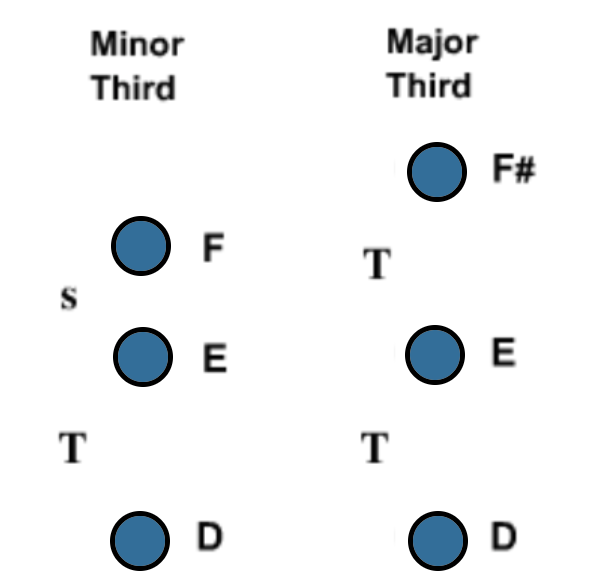
主1/3
次1/3
Observe that the minor third is smallerbecause it spans a whole tone plus a semitone (T+s). The major third, bycontrast, is larger because it spans two whole tones (T+T). Other intervalswith the same numerical name come in different sizes. These are given onExample 15, which compares thirteen common musical intervals, from the unison(the interval between notes of the same pitch) to the octave (the intervalspanning eight letters). The example lists the size of the interval insemitones and illustrates the intervals.
注意次1/3,因为它跨越了整个音调加半音(T + s)。相比之下,主1/3更大,因为它跨越了两个整个音调(T + T)。具有相同数字名称的其他音程具有不同的大小。这个在例15中给出,它比较来自同一音调(相同音高的音符之间的音程)与八度(跨越八个字母的音程)之间的十三个普通音程。该示例以半音列出音程的大小并说明音程。
Example 15. Intervals from the unison tothe octave
例15.从一致到八度的音程
| 名称 | 半音数量 | 可能情况 |
|---|---|---|
| Perfect Unison | 0 半音 | C#-C#, G-G, etc. |
| minor second | 1 半音 | C-Db, B-C, E-F, etc. |
| Major second | 2 半音 | C-D, A-B, F-G, etc. |
| minor third | 3 半音 | C-Eb, D-F, F#-A, etc. |
| Major third | 4 半音 | C-E, A-C#, Eb-G, etc. |
| Perfect fourth | 5 半音 | C-F, Db-Gb, F#-B, etc. |
| Augmented fourth diminished fifth | 6 半音 | C-F#, F-B, Eb-A, etc. C-Gb, B-F, D#-A, etc. |
| Perfect fifth | 7 半音 | C-G, Eb-Bb, D#-A#, etc. |
| Minor sixth | 8 半音 | C-Ab, F-Db, A-F, etc. |
| Major sixth | 9 半音 | C-A, F-D, A-F#, etc. |
| minor seventh | 10 半音 | C-Bb, D-C, G#-F#, etc. |
| Major seventh | 11 半音 | C-B, F-E, G-F#, etc. |
| (Perfect) Octave | 12 半音 | C-C, D-D, F-F, etc. |
Note that intervals of the second, third,sixth and seventh are divided into major and minor varieties. Intervals of thefourth and fifth (and also octave and unison) are ordinarily called perfect,but are called augmented and diminished respectively when they appear in largeror smaller varieties (i.e. one does not call them major fourths or minorfifths, etc.). Note also that the interval of the diminished fifth (i.e. theinterval a semitone smaller than the perfect fifth) is the same size insemitones as the interval of the augmented fourth (the interval a semitonelarger than the perfect fourth). The intervals differ in the pitches they span:C-Gb, spanning five letter names, is a diminished fifth whereas C-F#, spanningfour letter names, is an augmented fourth.
请注意,二度,三度,六度和七度的音程分为主要和小类别。四度和五度(以及八度和一致)的音程通常被称为是完美的,但当它们出现在更大或更小的类别(即,不叫做大四度或小五度等)时分别被称为增大和减小类。还要注意,五度减小的音程(即小于完美的五度半音的音程)与半音音程(半音大于完美的第四个半音的音程)是半音相同的大小。音程在它们的跨度上是不同的:跨越五个字母名称的C-Gb是减少的五分之一,而跨越四个字母名称的C-F#是增加的四分之一。
What about intervals larger than theoctave? Again, because of octave equivalence, intervals of the ninth, tenth,and so on, are considered equivalent to seconds, thirds, and so on, expanded byan octave (i.e. a ninth is a second plus and octave, a tenth is a third plus anoctave, etc.). The major ninth sounds similar to the major second, the minorthird sounds similar to the minor tenth, and so on (click on the examplesabove).
音程大于八度的呢?再次,由于八度等价,九度,十度等等的音程被认为相当于二分之一,三分之一等等,扩展了一个八度(即九度是二度和八度,十度是三度加一个八度等)。主要的第九度声音与主要的二度相似,小三度声音与十度相似,等等(点击上面的例子)。
 Consonance and Dissonance
Consonance and Dissonance
和谐音与不和谐音
Pitch Structure: Consonance and Dissonance
音高结构:和谐音与不和谐音
When two different notes sound together,those sounds may blend into one another almost indistinguishably--something wealready observed with notes distant by an octave. By contrast, notes soundingtogether at other intervals do not blend so well, or may even clash with oneanother. For example, notes distant by a major seventh clash when soundedtogether (click on sounds in table below).
当两个不同的音符合在一起时,这些声音混合在一起,可能几乎无法区分 - 我们已经用远离八度的音符观察到了。相比之下,其他时段的音符混合不好,甚至可能相互冲突。例如,当一起响起时,远离大七度的音符碰撞在一起(点击下表中的声音)。
Intervals whose notes blend or else soundpleasing when heard simultaneously are called consonances. Intervals whosenotes clash or sound unpleasant when heard together are called dissonances. Iemphazize, however, that the distinction between consonance and dissonance isnot based on objective criteria, but rather is a subjective,culturally-conditioned distinction--what is pleasing to one person may becacophonous to another and vice-versa. For hundreds of years in Western musicalculture (from as far back as 14th century), the following division of intervalswas observed:
音符混合或其他被同时听
到时,很悦耳的音程被称为和谐音。一起听到时音符冲突或不愉快的音程称为不和谐音。然而,我强调,和谐音与不和谐音之间的区别并不是基于客观的标准,而是一种主观的,文化上的区别– 有些对于一个人来说是喜悦的,可能对另一个人来讲是不开心的,反之亦然。在西方音乐文化(从十四世纪起)的数百年中,观察到了以下的音程:
| Consonant Intervals 和谐音程 | Dissonant Intervals 不和谐音程 |
| Unison 一度 | minor second 小二度 |
| Octave 八度 | Major second 大二度 |
| Perfect fifth 纯五度 | Augmented fourth 增四度 |
| Major third 大三度 | Diminished fifth 减五度 |
| minor third 小三度 | Major seventh 大七度 |
| Major sixth 大六度 | Minor seventh 小七度 |
| minor sixth 小六度 | |
Perfect fourth 纯四度 | |
These distinctions hold true for octaveexpansions of each interval (i.e. minor ninths are dissonant, Major tenths areconsonant, etc.). NOTE: The Perfect fourth (see table above) is sometimesconsidered consonant and sometimes dissonant, depending on the context in whichit occurs. A full explanation of the fourth and its usage is beyond the scopeof the present tutorial.
Larger collections of simultaneouslysounding notes (called chords) are deemed consonant or dissonant depending uponwhether or not they contain dissonant intervals. Listen, for example, to thethumping chords that open Stravinsky's "The Augurs of Spring (Dances ofthe Young Girls)" from the Rite of Spring.
这些区别适用于每个音程的八度扩展(即,小九度是不和谐音,大十度是和谐音等)。注:纯四度(见上表)有时被认为是和谐音,有时是不和谐音,取决于它的环境。四度及其用法全面的解释超出了本教程的范围。判断同时发声的音符(称为和弦)的较大集合是和谐音还是不和谐音,取决于它们是否包含不和谐音的音程。例如,听听Stravinsky的“春天的八重奏(少女的舞蹈)”的大和弦。
Example 22.
例22。
Listen to the entire chord played on thepiano:
听钢琴上演奏的整个和弦:
Did you hear the "crunchiness" ofthe sound? That crunch or clash arises from serveral dissonant intervals formedamong the pitches of the chord. For example, the chord includes a major seventhbetween Cb and Bb:
你听到这个声音的“脆弱”吗?这种紧缩或冲突来自于和弦音调之间形成的不和谐的音程。例如,和弦包括Cb和Bb之间的大七度:
a major seventh between Fb and Eb:
在Fb和Eb之间的大七度:
an Augmented fourth between G and Db:
G和Db之间的增四度:
an Augmented fourth between Fb and Bb:
Fb和Bb之间的增四度:
and a Major second between Db and Eb:
而Db和Eb之间的大二度:
In the next section, we will look at someconsonant chords--chords that contain no dissonant intervals. These are themajor and minor triads.
在下一节中,我们将会看到一些包含不和谐音程的和弦。这些是大小三和弦。
Dissonant intervals (and chords) wereconsidered to be unstable by composers of Western classical music before thetwentieth century; such sounds created musical tension that requiredresolution. Consonant intervals and chords, by contrast, were consideredstable; they were more restful and provided the resolution demanded bydissonant intervals and chords. In the twentieth century, composers likeStravinsky began to explore the beauty of dissonant intervals and chords (likethe one in Example 22), and used them for their own sake without their needingto resolve anywhere. The way composers used and treated dissonances in thetwentieth century marked one of the big changes in musical style that definedmodern classical music.
西方古典音乐作曲家在二十世纪以前认为不和谐的音程(和弦)是不稳定的;这种声音产生了需要解决的音乐紧张感。相辅相成的音程和和弦被认为是稳定的;他们更加宁静,并提供了不和谐的音程和和弦所要求的决议。在二十世纪,像Stravinsky这样的作曲家开始探索不和谐音程和和弦的美妙(如例22中的那个),并且为了他们自己而使用它们,而不需要在任何地方解决。二十世纪作曲家使用和处理不和谐音的方式标志着定义了现代古典音乐的音乐风格的重大变化之一。
 Triads
Triads
三和弦
Pitch Structure: Triads
音高结构:三和弦
A triad is a chord containing three notes:a lowest note (called the root), a note in the middle (called the third) whichlies at the interval of a third above the root, and a higest note (called thefifth) which lies at the interval of the fifth above the root. Example 23illustrates two particular kinds of triads: the Major triad (consisting of aMajor third and a perfect fifth above the root) and the minor triad (consistingof a minor third and a perfect fifth above the root).
三和弦是一个包含三个音符的和弦:最低的音符(称为根音),中间的音符(称为三度),位于根音高三分之一的音高处,以及最高的音符(称为五度)位于根之上的五度音程处。例23说明了两种特殊类型的三和弦:大三和弦(包括大三度和纯五度)和小三和弦(包括音根上一个小三度和纯五度)。
Example 23. Major and minor triads.
例23.大三和弦和小三和弦。
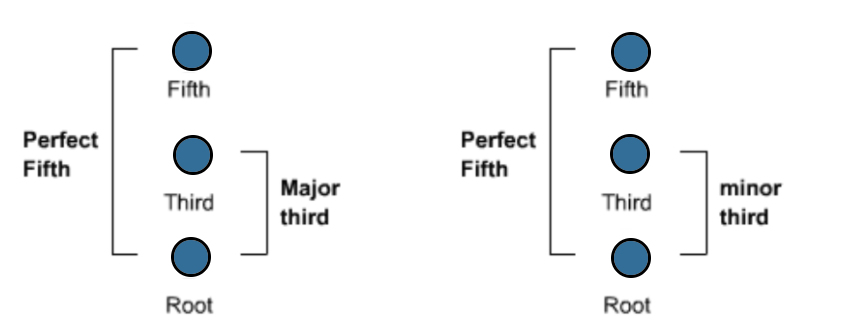
大三和弦
小三和弦
Particular triads are named for theirroots. Thus a C-major triad consists of the notes C-E-G: C is the root, thethird is E and the fifth is G. A c-minor triad consists of the root C, thethird Eb and the fifth G. A D-major triad consists of the notes D-F#-A, ad-minor triad consists of the notes D-F-A and so on.
特殊的三和弦以其音根命名。因此,一个C大三和弦由C-E-G音符组成:C是根,三度是E,五度是G.一个C小三和弦由C,三度Eb和五度G组成。一个D-大三和弦由音符D-F#-A组成,d小三和弦由音符D-F-A等组成。
The way in which triads are defined aboveis abstract in the way scales are abstract. Just as composers uses notes of thescale as they wish (and are not confined to their stepwise order), so too arecomposers free to employ triads in arrangements other than those shown inFigure 23. The intervals between notes of a chord may be expanded by octaves(e.g. with tenths or twelfths instead of thirds and fifths), notes of the chordmay be duplicated in different octaves, notes may be left out, the root neednot be the lowest note in the chord, and so on.
上面定义三和弦的方式在音阶的方式上是抽象的。正如作曲家按照自己的意愿使用音阶音符一样(并且不限于其逐步顺序),作曲家也可以自由地采用该方式,图23所示的其他配音方式除外。和弦音符之间的音程可以扩大(例如十度或十二度而不是三度和五度),和弦的音符可以被复制到不同的八度,可以省略音符,根不需要是和弦中的最低音符,等等。
Example 24. Minor triad, from Handel,"He trusted in God," conclusion.
例24.Handel的小三和弦“他相信上帝”的结论。
For example, Handel's "He trusted inGod" ends with the chorus singing a minor triad (on the word"Him" N.B. it is not the only triad in the passage!). Example 24illustrates the pitches from the final chord
例如,Handel的“他相信上帝”最后以合唱团唱小三和弦结束(在“他”这个词上,这不是乐段中唯一的三和弦!)。例24说明了最后一个和弦的音高。
The sopranos double the root two octavesabove the basses.
女高音歌手把高音的两个八度音阶加倍。
The altos sing the next higher fifth.
中音歌手高唱第五高。
The tenors sing the third in a higheroctave.
男高音在更高的八度中唱三度。
The bases sing the root of the triad
基础者唱三和弦的根
Listen again to the entire chord, played ona piano.
再听一遍钢琴演奏的整个和弦。
Often, instead of playing all the notes ofa triad as a chord, a composer might choose to string the notes out one at atime. Such an arrangement is called an arpeggio.
通常情况下,作曲家可能会选择一个一个地串出一个音符,而不是把三和弦的所有音符作为一个和弦。这样的安排被称为琶音。
Example 25.Major triad, from Handel,"Why do the Nations so Furiously Rage Together."
例25. 亨德尔的大三和弦:“为什么民族如此疯狂地一起暴动”。
Example 25 presents Handel's aria "Whydo the Nations so Furiously Rage Together," also from the Messiah. Thesinger of the excerpt begins by arpeggiating the notes of major triad, singingfirst the root, then the third, then the fifth, then the root an octave higher,then the third above that. (Did you also notice that the singer concludes the passageby singing down the notes of a major scale?)
例25展示了Handel的咏叹调:“为什么民族如此疯狂地一起暴动”也是来自《弥赛亚》。摘录的歌手开始的琶音大三和弦的音符,先唱根,然后是三度,然后是五度,然后根音高八度,然后是高于前者的三度。(你是否也注意到歌手通过唱出大规模的音符来结束乐段?)
As mentioned in the last page, major andminor triads are special in that they are the only consonant three note chordsin music--no matter how one arranges the notes that make up either a major orminor triad, the intervals between all pairs of notes will be consonant.Further, one cannot add any new notes to a triad without creating dissonantintervals in the enlarged collection.
正如最后一页所述,大小三和弦的特殊之处在于它们是音乐中唯一的和谐三和弦 - 无论如何排列组合大小三和弦的音符,在成对的音符之间的音程是不和谐的。此外,在不增加不和谐的音程的前提下,我们不能在扩大的集合中创建新的音符到三和弦中。
 Scales and Keys
Scales and Keys
音阶和调
Pitch Structure: Scales and Keys
音高结构:音阶和调
The major and minor scales are more thansimply collections of notes. In Western classical music, the scale degreespossess various degrees of tension that seek their resolution in the tonicnote. The ability of the tonic to exhibit a "gravitational pull" onthe other notes of the scale--to be the gravitational center of a scale--is oneof the most profound aspects of Western classical music. This weighty idea canbe illustrated by even so simple an example as chopsticks.
大小音阶不仅仅是音符的集合。在西方古典音乐中,音阶具有不同程度的张力,在音调中寻求解决。主音在音阶的其他音符上表现出“引力拉”的能力 - 成为音阶的引力中心 - 是西方古典音乐最深刻的一个方面。甚至可以用筷子这样简单的例子来说明这个重要的想法。
Example 26 illustrates schematically thechopsticks progression using notes from a C-major scale.
例26表示了使用来自C大音阶的音符的筷子式进展。
Example 26. The chopsticks progression.
例26.筷子式进展。
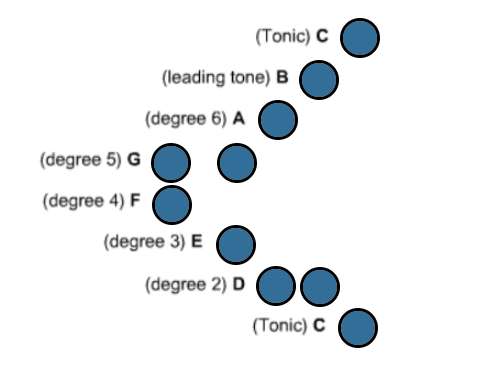
On the example scale degrees 5 through 7ascend to scale degree 1 in the upper part, while scale degrees 4 through 2descend to scale degree 1 in the lower part. To someone immersed in Westernclassical music (as well as much popular music), the penultimate sonority has agreat deal of tension, not because the interval between the notes is dissonant(it is a consonant major sixth between D and B), but rather because theindividual scale degrees have a strong tendencies to move: scale degree 7, theleading tone, has a need to resolve up to the tonic (and thus the name leadingtone); scale degree 2 has a similar need to resolve down to the tonic. Thefinal sonority , the doubled tonic, is by contrast stable and at rest--again,not because of the interval of the octave, but because the tonic note is themost stable degree of the scale; it is a goal attained.
This phenomenon, that the tonic of a scaleis the point of repose and the tone to which all other tones of the scalerelate and refer, is known as tonality. Music that exhibits this phenomenon iscalled tonal music. Tonality is one of the most difficult concepts in music,and all of its aspects cannot be detailed in this tutorial--it is a conceptthat one comes to understand over time, from experiencing many tonal pieces.While the pages that follow will try to shed more light on tonality and what itmeans, it is expected that these pages will be a mere starting point that willopen up a dialogue between you, your TF and the other students.
在例子中,5到7级上升到1级,而4到2级下降到1级。对于沉浸在西方古典音乐(以及流行音乐)中的人来说,倒数二度音乐会有很大的紧张感,不是因为音符之间的音程是不和谐的(这是D和B之间的辅音大六度),而是因为个体音阶有强烈的移动趋势:导音音阶7度有解决主音的需要(因此命名为导音);音阶度2有类似的需要解决的主音。最后的声音,双重主音,相比之下是稳定的和静止的 - 再次,不是因为八度的音程,而是因为主音音符是最稳定的音阶;这是一个目标达成。
这种现象,即音阶的主音是静止的,而音阶的所有其他音调所关联和引用的音符被称为音调。表现这种现象的音乐被称为音调音乐。音调是音乐中最困难的概念之一,所有的方面都不能在本教程中详细说明 -随着时间的推移,体验许多音调片断,以加深理解。虽然接下来的页面会试图说明音调及其意义,但这些页面预计只是一个开始,将会和你有个对话,你的任务小组和其他学生之间的对话。
When a major or minor scale is understoodnot simply as a stepwise ordering of notes, but as a collection of notes thatrevolve around and seek resolution in a tonic note, then those scales defineparticular musical keys. A key (not to be confused with keys that are depressedon keyboard instruments, like pianos) is a collection of notes that all relatedto, and gravitate toward, a central, tonic note. In the example above, the noteC is the tonic note of the C-major scale, and the progression of Example 26 isa tonal progression in the key of C-major. A piece of music that uses notes ofthe G-major scale in a way that gravitates around and resolves to G is said tobe in the key of G-major. A piece of music that uses notes of the E-minor scaleand whose notes gravitate around and resolve to the tone E is said to be in thekey of E-minor, and so on.
当大小音阶不仅仅被理解为音符的逐步排序,还被理解为音符的集合,并且在主音音符中寻求方法时,那么这些音阶就定义了特定的音符。调(不要与键盘乐器上的琴键混淆,如钢琴)是一组音符,所有音符都与中央音调有关,并且被吸引。在上面的例子中,音符C是C大调音阶的主音,而例26的进程是C大调音调中的音调进程。被认为是G大调的关键,一个使用G大调音阶的音乐以一种吸引人的方式来弹奏G的音乐。一个音乐使用电子小调的音符,其音符吸引和演奏的音调E被认为是在电子小调的关键,等等。
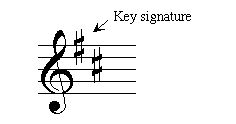
Figure 13.
图13。
A NOTE ABOUT NOTATION: Since musical worksin a particular key predominantly use the notes of the major or minor scaleassociated with that key, one avoids writing hundreds of accidentals byaffixing a key signature to the musical staff. The key signature allows one tosay at the beginning of the work, which accidentals will be used throughout.For example, we observed earlier that the D-major scale consists of the notesD-E-F#-G-A-B-C#-D. Figure 13 illustrates the key signature for D-major: twosharp signs are placed on the F-line and C-space of the staff. The signatureindicates to the reader of the music that all Fs and all Cs are sharp unlessotherwise noted.
关于符号的注意事项:由于音乐作品在特定的音调中主要使用与该音调关联的大小音阶,所以通过在五线谱身上附上调的说明来避免很多跑调。调的说明允许人们在工作开始时说出哪些偶然调将会使用。例如,我们之前曾经观察到,D大调由音符D-E-F#-G-A-B-C#-D组成。图13显示了D-大调的主要说明:在五线谱的F线和C-space上放置了两个尖锐的标志。除非另有说明,否则说明向音乐的读者指出所有的F和所有的C都是尖锐的。
 The Chromatic Scale
The Chromatic Scale
半音音阶
Pitch Structure: The Chromatic Scale
音高结构:半音音阶
We earlier saw how the keys on pianokeyboard are arranged by semitone. When those keys are played up or down inorder, the resulting scale of ascending or descending semitones is known as thechromatic scale. Example 27 again illustrates an ascending chromatic scale on apiano keyboard.
我们之前看过钢琴键上的按键是以半音的方式排列的。当这些键被按顺序放大或缩小时,由此产生的升高或降低的半音的音阶被称为半音音阶。例27再次示出了钢琴键盘上的升序半音音阶。
Example 27. The chromatic scale.
例27.半音音阶。

Observe that we say "The"chromatic scale. Although one can begin or end a chromatic scale on any note,there is no tonic note in a chromatic scale--no predetermined boundary note.This is because all notes of the scale are equidistant--one cannot orientoneself or distinguish one note from another intervallically. Thus althoughthere are C-major scales, F-major scales, g-minor scales, etc., the chromaticscale is simply called the chromatic scale, and composers choose to usewhatever portions of it they choose. sometimes a composer will use notes of thechromatic scale to make a passage of music more expressive. Watch the keyboardand listen to the following excerpt from Mozart's Rondo in A-minor (KV 511),which uses an expressive ascending chromatic scale from A to E.
观察我们说的“半音音阶”。虽然可以在任何音符上开始或结束半音音阶,但在半音音阶中没有音调 - 没有预定的边界音符。这是因为所有的音符都是等距的– 音符不能自己定位,也不能把一个音符与另一个音符相互区分。因此,尽管存在C大调,F大调,g小调等,但是半音音阶仅被称为半音音阶,并且作曲者选择使用它的任何部分。有时候一个作曲家会使用半音音符来使音乐更具表现力。观看键盘,听听莫扎特的A-minor(KV 511)中的Rondo的摘录,它使用从A到E的表现性递增半音音阶。
The passage illustrates an important aspectof tonality: even though the passage uses notes outside of the white-noteA-minor scale, the key of A-minor is not lost--A is still the center of gravityin the passage. (Mozart in fact ends the excerpt with a descending a-minorscale that concludes on the leading tone G#. One could not experience this noteas a leading tone were A not still exerting its tonal supremacy.) Thus,tonality and the sense of key have the ability to transcend the notes of ascale. Yet because all the intervals between notes of the chromatic scale arethe same size, chromatic scales or chromatic notes used in abundance, can, likea hall of mirrors, create disorientation, suspending one's awareness of thetonal center.
这片乐段说明了音调的一个重要方面:即使这片乐段使用的是白音A小调音阶以外的音符,A小调的琴键都不会丢失 - A仍然是这片乐段中的重心。(莫扎特事实上以下降的小音阶结尾,结束于G#的主音音调,没有人能体验到这个音符,因为主音不是仍然在发挥其音调优势。)因此,调性和关键感有能力超越规模的音符。然而,因为半音音符之间的所有音程都是相同的大小,所以大量使用的半音阶或色调音符可能像镜子大厅一样造成迷失方向,阻碍对音调中心的认识。
 Harmony and Counterpoint
Harmony and Counterpoint
和谐与对立
Pitch Structure: Harmony and Counterpoint
音高结构:和谐与对立
The term harmony has two meanings in music.A harmony can refer to an individual chord or triad that occurs in a work ofmusic ("harmony" in this sense refers to the togetherness of disparatenotes when they join together to make a triad or chord). Harmony also refers tothe "logical" way chords or harmonies progress in tonal music. Thefollowing example, from the chorale "Du Lebensfuerst , Herr JesuChrist" from J. S. Bach's Cantata Gott faehret auf mit Jauchzen, willillustrate these two ideas.
和谐这个词在音乐中有两个意思。和声可以指音乐作品中出现的个人和弦或三和弦(在这个意义上的“和谐”是指不同音符联合起来形成三和弦或和弦时的统一性)。和声也是指和声或和声在和声音乐中的“逻辑”方式。下面的例子,来自J. S. Bach的“Cantata Gott faehret auf mit Jauchzen”的合唱团“Du Lebensfuerst,Herr JesuChrist”将会说明这两个观点。

和声演唱
钢琴演奏
The passage is made up of a series ofchords (if you have not done so already, try listening to the passage played ona piano--the piano version may make the individual chords easier to hear). Thefirst chord of the passage is a G-major triad; the second chord of the passageis an e-minor triad; the third chord is a D-major triad; the fourth chord isanother G-major triad, and so on. One sometimes refers to these as "aG-major harmony," "an e-minor harmony," and so forth. However,the chorale is a tonal piece of music, written in the key of G-major (i.e. it usesthe tones of a G-major scale, G-A-B-C-D-E-F#-G, and G is the gravitationalcenter). One therefore often uses different names for the triads. Since G isscale degree 1, the triad built on G (i.e. whose root is G) is called theI-chord in the key of G-major (N.B. one uses the Roman numeral instead of theArabic when describing the triad). Simlarly, the triad built on E (scale degree6 in G-major) is called the vi-chord (we use small Roman numerals because thetriad is minor). The triad built on D (scale degree 5 in G-major) is called theV-chord. One therefore also refers to "the harmony on I," "theharmony on ii," etc. when talking about individual chords in the contextof a key.
这片乐段是由一系列的和弦构成的(如果你还没有这样做,试听一下钢琴演奏的乐段 - 钢琴版本可能会使得和弦更容易听到)。这片乐段的第一个和弦是G大调三和弦;这片乐段的二度和弦是一个电子小调三和弦;第三和弦是D大调三和弦;第四个和弦是另一个G大调黑三和弦,等等。人们有时把它们称为“G大调和音”,“e小调和音”等等。然而,合唱是用G-大调(即使用G-G-A-B-C-D-E-F#-G,G是引力中心)的音调写成的音调。因此,经常对三和弦使用不同的名字。由于G是音阶度为1,所以建立在G上的三和弦(即其根是G)在G-大调(N.B.在描述三和弦时使用罗马数字而不是阿拉伯数字)的调被称为I-和弦。同样地,建立在E(在G大调的第6级)的三和弦被称为vi和弦(我们使用小罗马数字,因为三和弦是轻微的)。以D为基础的三和弦(G-5级)被称为V弦。因此,在一个关键词的背景下谈论个别和弦时,也就是指“和谐I”,“和谐II”等等。
Harmony in the more abstract sense refersto the progression of individual chords (or harmonies) in a work. In thechorale example, the opening progression of triads, I-vi-V-I, is a harmonicprogression that departs from and returns to the triad build on the tonic G(also called the tonic triad).
更抽象意义上的和谐是指作品中和弦(或和声)的进展。在合唱团的例子中,三和弦的开放进程I-vi-V-I是一个和谐的进程,离开并返回到强化G(也称为强补三联)的三和弦基础上。
The passage illustrates another feature oftonality. The asterisk above the staff marks the appearance in the highestvoice of the note C#, a note that does not belong to the key of G-major.Rather, the A-major triad to which that C# belongs is not a harmony in the keyof G-major, but a V-chord in the key of D-major that resolves to the I-chord inD-major (remember the D-major scale consists the notes D-E-F#-G-A-B-C#-D). Inother words, by introducing the leading tone of a different key, Bachtemporarily changes the key center, making D a new tonic. This change of tonicis called a modulation. Bach returns to G-major, concluding the passage in theoriginal key, confirming that key with a V-I progression in G-major (alsocalled a cadential progression or cadence because it "falls"--L.cadere--back to the tonic). Modulations in larger works of music can last muchlonger, or works may modulate to many different keys before returning to theirhome key. Your TF can discuss modulation in greater detail. The big point isthat tonality is hierarchical: just as notes progress to other notes, andchords progress to other chords, so too can keys progress to other keys.
该乐段说明了音调的另一个特点。五线谱上方的星号表示注释C#最高音的出现,不属于G-大调。相反,C#所属的A大调三和弦并不是G大调的调,而是D大调的调中的V和弦,可以解决D大调中的I和弦(记住D大调由音符DEF#-GABC#-D组成。换句话说,通过引入不同关键的主音,巴赫暂时改变了关键中心,使D成为一种新的主音。主音的这种改变称为调制。巴赫返回到G大调,结束在原来调的乐段,确认调与六大进展G大调(也称为一个进步或节奏,因为它“跌”回到主音)。较大音乐作品中的调制可以持续更长时间,或者在返回其主键之前可以调制许多不同的键。您的任务小组可以更详细地讨论调制。最重要的是音调是分层次的:就像其他音符的音符进度一样,和弦进行到其他和弦,键也可以进入其他和弦。
Counterpoint refers to the joining togetherof individual melodic lines to create a work of music.
对位指的是将个别旋律线条连接在一起以创作音乐作品。
Listen to the opening of "And with hisstripes" from Handel's Messiah
听来自亨德尔的《弥赛亚》的“和他的条纹”的开头
The passage begins with the sopranossinging the following melody by themselves:
这段话始于女高音自己唱出如下旋律:
Shortly thereafter, the altos begin singinga melody whose opening echoes what the sopranos just sang:
不久之后,中音歌手开始唱起一首旋律,其开场回响了女高音刚唱出的歌曲:
Yet while the altos are singing, thesopranos begin to sing a different melody against the alto part:
然而,当高音歌唱的时候,女高音们开始对中音部分唱出不同的旋律:
In other words, the sopranos are singing atune that "counters" the tune in the alto part. (NOTE: "And withhis stripes" is an example of imitative counterpoint--the altos imitatewhat the sopranos sang. Not all counterpoint involves imitation, althoughimitation is a common contrapuntal device because it helps the listenerrecognize and hear the individual melodic lines.)
Counterpoint is often considered to be theopposite of harmony: whereas harmony views music "vertically," as asuccession of chords, counterpoint looks at music "horizontally," asthe simultaneous joining of melodies. This distinction is somewhat misleadingif it suggests to us that some works are "harmonic" whereas othersare "contrapuntal." Rather, elements of both harmony and counterpointplay a role in most classical music, although our attention may be directedmore to one or the other. Consider, for example the Bach chorale above.Although we looked at the work from the perspective of its triads and theirprogression, the work is also contrapuntal: it combines four individual melodiclines sung by different parts of the chorus. Listen to each of the individual melodiesthat make up the chorale, then listen the the chorale as a whole:
换句话说,女高音正在唱一首“低音”的曲调。(注:“他的条纹”就是一个模仿对位的例子– 男高音模仿着女高音演唱,并不是所有的对位都包含模仿,尽管模仿是一个常用的对位装置,因为它能帮助聆听者识别和听到各个旋律线。)
对立常常被认为是和谐的反面:而和声则把音乐“垂直”地看作是和弦的连续体,而对立面把音乐“水平地”看作旋律的同时连接。这种区分有点误导,如果它表明一些作品是“谐波”,而另一些则是“对位”。相反,和谐与对立的元素在大多数古典音乐中扮演一个角色,尽管我们的注意力可能更多地集中在某一方面。考虑一下,比如上面的巴赫合唱团。虽然我们从三和弦的角度来看作品,但是这个作品也是对立的:它把合唱的不同部分所唱的四首旋律组合在一起。聆听组成合唱的各个旋律,然后听整个合唱:
Soprano part 女高音部分
Alto Part 中音部分
Tenor Part 男高音部分
Bass Part 基音部分
All Parts (piano) 所有部分(钢琴)
All Parts (chorus) 所有部分(合唱)
Similarily the contrapuntal joining ofmelodic lines in "And with his stripes" is done in such a way as tocreate harmonies and harmonic progressions. Listen first to the combinedmelodies of the alto and soprano lines, then listen to the progression ofcomplete triads those individual lines imply.
类似地,“和他的条纹”中的旋律线的对立连接以这种方式完成,以创建和声和谐音进程。首先听一下中音和女高音线的组合旋律,然后听听那些个别行所暗示的完全三和弦的进展。
Play the lines
弹奏这些歌词
Play the the implied harmonies
弹奏隐含的和声
A nice metaphor to describe therelationship of harmony and counterpoint is consider the relation of horizontaland vertical design in an ornately patterened woven rug. The pattern arisesfrom many parallel strands of multi-colored wool. Yet without some guidingprinciple to control the alignment of those individual strands, the patternwould quickly fall into chaos.
描述和谐与对立关系的一个很好的比喻就是考虑水平和垂直设计的关系。这种模式来自许多平行的多色毛线。然而,如果没有一些指导原则来控制这些个股的走向,这种模式很快就会陷入混乱。


